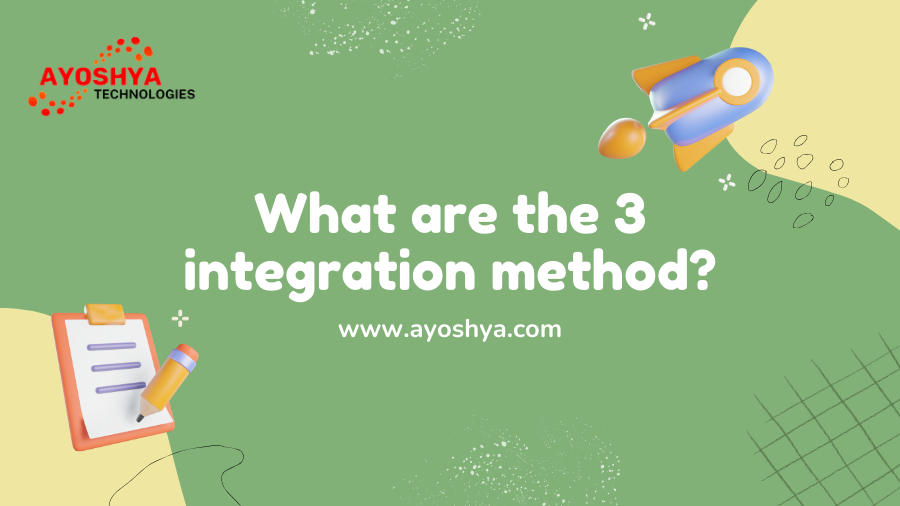What are the 3 integration method?
In the bustling digital landscape, where data flows like a mighty river and applications jostle for attention, integration reigns supreme. But like navigating a labyrinth, choosing the right path can be daunting. Fear not, for this in-depth exploration delves into the three main integration methods, illuminating their strengths, weaknesses, and ideal applications. So, equip yourself with the knowledge to traverse the complex terrain of data unification and unlock the true potential of your digital ecosystem.
Demystifying the Trio: Defining the 3 Main Integration Methods
Before embarking on our journey, let’s set the stage by introducing the three integration heroes:
1. Point-to-Point Integration: Imagine two isolated islands connected by a single, custom-built bridge. This is the essence of point-to-point integration, a direct connection between two specific applications or systems.
2. Enterprise Application Integration (EAI): Think of a robust network of bridges and highways interconnecting multiple islands. EAI acts as a centralized platform, orchestrating integrations between various applications and data sources within an organization.
3. Application Programming Interface (API)-Centric Integration: Picture a bustling marketplace for pre-built bridges, where applications connect and exchange data through standardized protocols. API-centric integration leverages readily available APIs to facilitate a flexible and scalable approach to data exchange.
Unveiling the Strengths and Weaknesses: A Comparative Lens
Now, let’s delve deeper into the strengths and weaknesses of each method:
Point-to-Point Integration:
- Strengths:
- Simple and straightforward for basic integrations.
- Cost-effective for limited needs.
- Tightly coupled connection ensures high data consistency.
- Weaknesses:
- Lack of flexibility and scalability.
- High maintenance costs for managing multiple point-to-point connections.
- Difficult to adapt to changing requirements or add new integrations.
EAI:
- Strengths:
- Robust and centralized platform for complex integrations.
- Offers scalability and flexibility for expanding ecosystems.
- Provides data transformation and mapping capabilities.
- Weaknesses:
- Higher initial investment required for implementation and maintenance.
- Can be complex to configure and manage.
- May struggle with integration agility in some cases.
API-Centric Integration:
- Strengths:
- Highly flexible and scalable for diverse integrations.
- Faster and easier to implement than other methods.
- Promotes loose coupling, facilitating easier adaptation and updates.
- Weaknesses:
- Security considerations, as data flows through publicly accessible APIs.
- May require dependency on external API providers.
- Not suitable for tightly coupled integrations with strict data consistency needs.
The Art of Matching: Choosing the Right Integration Method for Your Needs
With the strengths and weaknesses revealed, the next step is finding the perfect fit for your integration needs:
- Point-to-Point Integration: Ideal for simple, static connections between two specific systems with limited future change requirements.
- EAI: A wise choice for complex integrations involving multiple applications and data sources, especially within large organizations.
- API-Centric Integration: Perfect for agile and scalable integrations, particularly when connecting with external applications or leveraging existing API marketplaces.
The Future of Integration: A Glimpse into the Evolving Landscape
The digital landscape is ever-evolving, and so too are integration methods:
- Hybrid Integration: Combining elements of different methods, allowing organizations to tailor their approach to specific needs.
- Event-Driven Integration: Applications react to real-time events in other systems, enabling dynamic and responsive data exchange.
- Microservices Architecture: Breaking down applications into smaller, independent services that communicate through APIs, fostering agility and scalability.
A Call to Action: Embrace the Power of Integration and Unify Your Digital Ecosystem
Understanding the three main integration methods and their nuances empowers you to make informed decisions and forge seamless connections within your digital landscape. Whether you’re navigating a simple point-to-point bridge or building a complex network of data highways, remember: Integration is a powerful tool that unlocks the true potential of your applications and data, driving efficiency, agility, and innovation towards a unified and thriving digital ecosystem.
You may be interested in:
Configure Process Visibility Dashboard & Integration with Fiori Launchpad
A Comprehensive Guide to Web Development Frameworks in UI5



